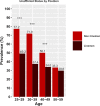Healthspan and chronic disease burden among young adult and middle-aged male former American-style professional football players
- PMID: 36588423
- PMCID: PMC9887383
- DOI: 10.1136/bjsports-2022-106021
Healthspan and chronic disease burden among young adult and middle-aged male former American-style professional football players
Abstract
Objective: To examine the relationships between age, healthspan and chronic illness among former professional American-style football (ASF) players.
Methods: We compared age-specific race-standardised and body mass index-standardised prevalence ratios of arthritis, dementia/Alzheimer's disease, hypertension and diabetes among early adult and middle-aged (range 25-59 years) male former professional ASF players (n=2864) with a comparator cohort from the National Health and Nutrition Examination Survey and National Health Interview Survey, two representative samples of the US general population. Age was stratified into 25-29, 30-39, 40-49 and 50-59 years.
Results: Arthritis and dementia/Alzheimer's disease were more prevalent among ASF players across all study age ranges (all p<0.001). In contrast, hypertension and diabetes were more prevalent among ASF players in the youngest age stratum only (p<0.001 and p<0.01, respectively). ASF players were less likely to demonstrate intact healthspan (ie, absence of chronic disease) than the general population across all age ranges.
Conclusion: These data suggest the emergence of a maladaptive early ageing phenotype among former professional ASF players characterised by premature burden of chronic disease and reduced healthspan. Additional study is needed to investigate these findings and their impact on morbidity and mortality in former ASF players and other athlete groups.
Keywords: cardiovascular diseases; chronic; football; osteoarthritis.
© Author(s) (or their employer(s)) 2022. Re-use permitted under CC BY-NC. No commercial re-use. See rights and permissions. Published by BMJ.
Conflict of interest statement
Competing interests: The Football Players Health Study is supported by the NFL Players Association. The NFL Players Association did not contribute to the design and conduct of the study; collection, management, analysis and interpretation of the data; preparation, review or approval of the manuscript; and decision to submit the manuscript for publication. This work received support from Harvard Catalyst | The Harvard Clinical and Translational Science Center (National Center for Advancing Translational Sciences, National Institutes of Health Award UL1 TR002541) and financial contributions from Harvard University and its affiliated academic healthcare centers. The content is solely the responsibility of the authors and does not necessarily represent the official views of Harvard Catalyst, Harvard University and its affiliated academic healthcare centers, or the National Institutes of Health. The authors wish to acknowledge the study participants, advisors and staff of the Football Players Health Study for their time and effort.
Figures



Similar articles
-
Tau Positron Emission Tomography and Neurocognitive Function Among Former Professional American-Style Football Players.J Neurotrauma. 2023 Aug;40(15-16):1614-1624. doi: 10.1089/neu.2022.0454. Epub 2023 Jun 28. J Neurotrauma. 2023. PMID: 37282582 Free PMC article.
-
Contributors to caregiver burden, depression, and anxiety in the partners of professional American-style football players: a cross-sectional study.Front Psychol. 2025 May 7;16:1581239. doi: 10.3389/fpsyg.2025.1581239. eCollection 2025. Front Psychol. 2025. PMID: 40400748 Free PMC article.
-
Multisystem afflictions in former National Football League players.Am J Ind Med. 2019 Aug;62(8):655-662. doi: 10.1002/ajim.22992. Epub 2019 May 27. Am J Ind Med. 2019. PMID: 31134638 Free PMC article.
-
Review of cardiometabolic risk factors among current professional football and professional baseball players.Phys Sportsmed. 2010 Oct;38(3):77-83. doi: 10.3810/psm.2010.10.1811. Phys Sportsmed. 2010. PMID: 20959699 Review.
-
A systematic review on the risk of neurodegenerative diseases and neurocognitive disorders in professional and varsity athletes.Neurol Sci. 2022 Dec;43(12):6667-6691. doi: 10.1007/s10072-022-06319-x. Epub 2022 Aug 17. Neurol Sci. 2022. PMID: 35976476 Free PMC article.
Cited by
-
Long-term risk of cardiovascular disease after traumatic brain injury: screening and prevention.Lancet Neurol. 2023 Oct;22(10):959-970. doi: 10.1016/S1474-4422(23)00241-7. Lancet Neurol. 2023. PMID: 37739576 Free PMC article. Review.
-
Tau Positron Emission Tomography and Neurocognitive Function Among Former Professional American-Style Football Players.J Neurotrauma. 2023 Aug;40(15-16):1614-1624. doi: 10.1089/neu.2022.0454. Epub 2023 Jun 28. J Neurotrauma. 2023. PMID: 37282582 Free PMC article.
-
Long-term function, body composition and cardiometabolic health in midlife former athletes: a scoping review.BMJ Open Sport Exerc Med. 2023 Oct 27;9(4):e001605. doi: 10.1136/bmjsem-2023-001605. eCollection 2023. BMJ Open Sport Exerc Med. 2023. PMID: 37920279 Free PMC article.
-
Dietary Approaches from Moms, Farms, and Nature to Overcome Chronic Diseases and the Pharmacracy.Nutrients. 2023 Sep 14;15(18):3965. doi: 10.3390/nu15183965. Nutrients. 2023. PMID: 37764749 Free PMC article.
-
Health and Lifestyle Factors and Dementia Risk Among Former Professional Soccer Players.JAMA Netw Open. 2024 Dec 2;7(12):e2449742. doi: 10.1001/jamanetworkopen.2024.49742. JAMA Netw Open. 2024. PMID: 39652348 Free PMC article.
References
LinkOut - more resources
Full Text Sources
